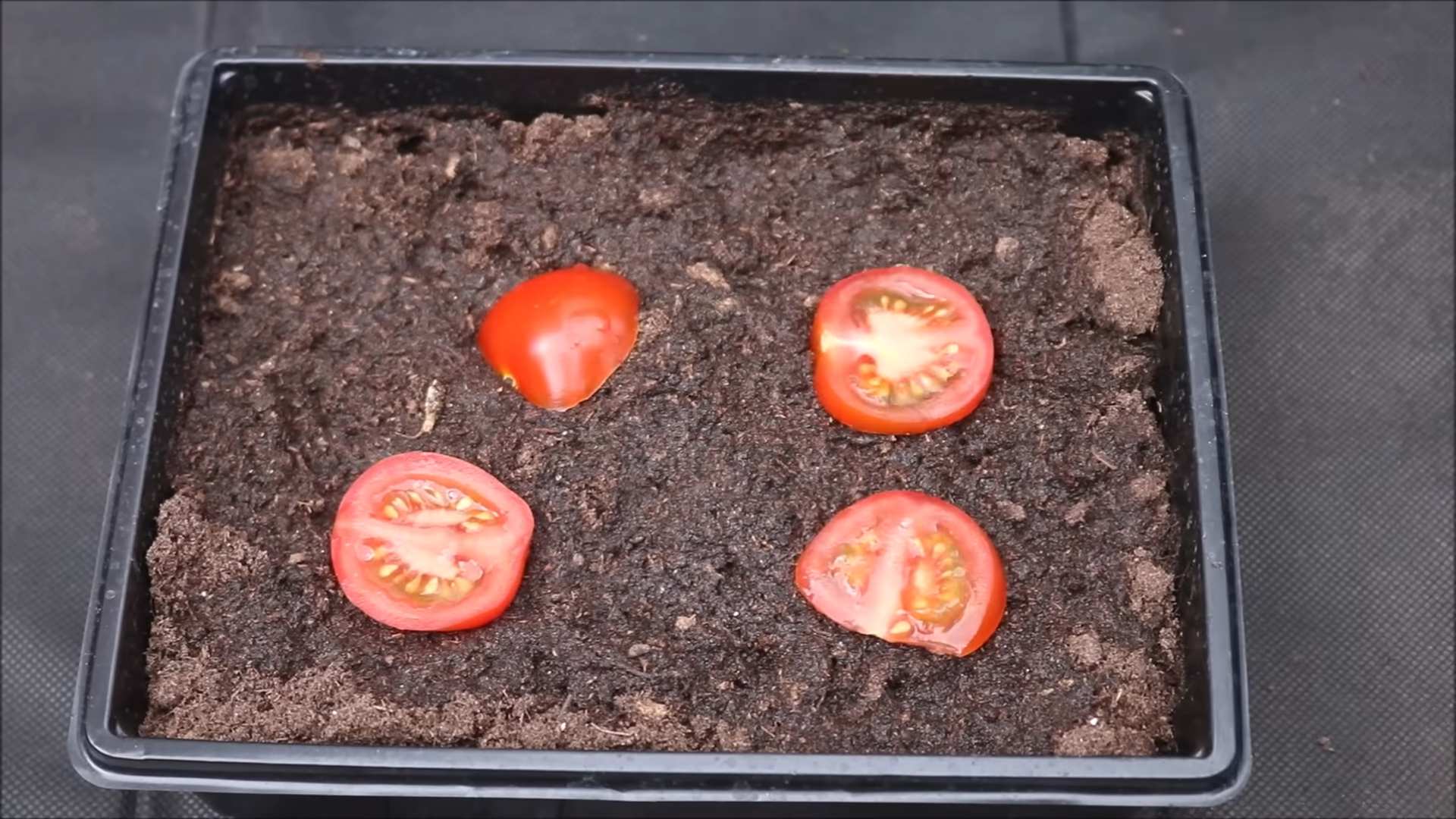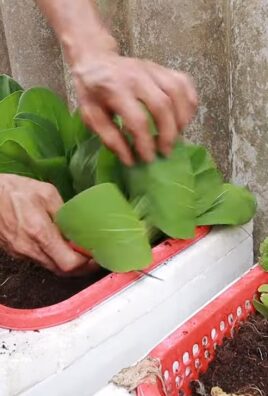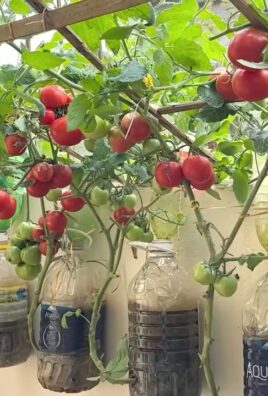Growing Tomatoes from Store Bought? Absolutely! Imagine sinking your teeth into a juicy, sun-ripened tomato that you grew yourself, all from a simple tomato you picked up at the grocery store. It sounds like magic, right? Well, it’s more science than sorcery, and I’m here to show you how!
For centuries, humans have cultivated tomatoes, transforming them from wild, unassuming berries into the vibrant, diverse fruits we enjoy today. From the Aztec gardens of Mesoamerica to the sun-drenched fields of Italy, the tomato has a rich and fascinating history. Now, you can become a part of that history, even if you don’t have a sprawling garden.
Let’s face it, buying fresh produce can be expensive, and sometimes, the tomatoes at the store just don’t have that homegrown flavor. That’s where this DIY trick comes in. Growing Tomatoes from Store Bought is a fantastic way to save money, reduce food waste, and experience the immense satisfaction of nurturing your own food. Plus, it’s a fun and educational project for the whole family! I’m going to guide you through the process, step-by-step, so you can enjoy delicious, homegrown tomatoes without breaking the bank. Get ready to unleash your inner gardener!

Growing Tomatoes from Store-Bought Tomatoes: A DIY Guide
Hey there, fellow gardening enthusiasts! Ever wondered if you could grow new tomato plants from the tomatoes you buy at the grocery store? Well, I’m here to tell you that you absolutely can! It’s a fun, rewarding, and surprisingly easy way to expand your garden without spending a fortune on seedlings. I’ve done it myself, and I’m excited to share my experience and guide you through the process.
Understanding the Basics
Before we dive in, let’s clarify a few things. Not all store-bought tomatoes are created equal when it comes to propagation. Hybrid tomatoes, which are common in supermarkets, might not produce offspring that are true to the parent plant. This means the tomatoes you get from the new plant might look or taste different from the original. Heirloom tomatoes, on the other hand, are more likely to produce plants that are similar to the parent. So, if you’re aiming for consistency, heirloom varieties are your best bet. Also, organic tomatoes are preferable as they are less likely to be treated with chemicals that could inhibit germination.
What you’ll need:
* A ripe tomato (preferably heirloom and organic)
* A sharp knife
* A cutting board
* Small pots or seed trays
* Seed starting mix or potting soil
* Water
* A sunny windowsill or grow lights
* Optional: A blender or food processor
* Optional: Coffee filters or paper towels
Extracting the Seeds
This is the first crucial step. We need to get those seeds out of the tomato and ready for planting.
1. Choose your tomato wisely: As I mentioned earlier, heirloom and organic tomatoes are ideal. Look for a tomato that is ripe, but not overly soft or bruised. Beefsteak, Roma, and cherry tomatoes are all good options.
2. Slice the tomato: Place the tomato on a cutting board and carefully slice it in half horizontally. This will expose the seed cavities.
3. Extract the seeds and pulp: There are a couple of ways to do this.
* Method 1 (The Scoop): Use a spoon to scoop out the seeds and surrounding pulp from each half of the tomato. Place the mixture into a small container.
* Method 2 (The Blend): This method is a bit faster. Cut the tomato into smaller chunks and place them in a blender or food processor. Add a little bit of water (about 1/4 cup) and pulse a few times. Be careful not to over-blend, as you don’t want to damage the seeds. The goal is to separate the seeds from the pulp.
4. Ferment the seeds (Important!): This is a key step that helps remove germination inhibitors and reduces the risk of disease.
* Add a bit more water to the container with the seeds and pulp.
* Cover the container loosely with plastic wrap or a lid.
* Let the mixture sit at room temperature for 3-4 days. You’ll notice a layer of mold forming on top – don’t worry, that’s a good sign! It means the fermentation process is working. The mixture will also start to smell a bit funky.
5. Rinse the seeds: After the fermentation period, rinse the seeds thoroughly under running water. Use a fine-mesh sieve or strainer to catch the seeds. Rub the seeds gently to remove any remaining pulp.
6. Dry the seeds: Spread the rinsed seeds on a coffee filter or paper towel in a single layer. Allow them to dry completely for about a week. Make sure they are in a well-ventilated area and out of direct sunlight. Properly dried seeds are crucial for successful germination.
7. Store the seeds: Once the seeds are completely dry, store them in an airtight container in a cool, dark, and dry place. A labeled envelope or a small jar works well. Properly stored tomato seeds can remain viable for several years.
Planting the Seeds
Now that we have our clean, dry seeds, it’s time to get them in the soil!
1. Prepare your planting containers: Fill your small pots or seed trays with seed starting mix or potting soil. Make sure the soil is moist but not waterlogged.
2. Sow the seeds: Make a small indentation (about 1/4 inch deep) in the soil in each pot or cell. Place 2-3 seeds in each indentation. This increases your chances of at least one seed germinating.
3. Cover the seeds: Gently cover the seeds with a thin layer of soil.
4. Water gently: Water the soil gently using a spray bottle or watering can with a fine rose. Avoid overwatering, as this can cause the seeds to rot.
5. Provide warmth and light: Place the pots or seed trays in a warm location, such as a sunny windowsill or under grow lights. Tomato seeds need warmth to germinate. The ideal temperature is between 70-80°F (21-27°C). If you’re using a windowsill, rotate the pots regularly to ensure even light exposure. If you’re using grow lights, keep them on for about 14-16 hours per day.
6. Maintain moisture: Keep the soil consistently moist, but not soggy. Check the soil moisture daily and water as needed. You can use a spray bottle to mist the soil surface.
7. Wait for germination: Tomato seeds typically germinate within 5-10 days, but it can sometimes take longer depending on the variety and environmental conditions. Be patient!
Caring for the Seedlings
Once your seedlings emerge, it’s important to provide them with the right care to ensure they grow into strong, healthy plants.
1. Thin the seedlings: Once the seedlings have developed their first true leaves (the leaves that appear after the initial seed leaves), thin them out by snipping off the weaker seedlings at the soil line. Leave only the strongest seedling in each pot or cell.
2. Provide adequate light: Seedlings need plenty of light to grow properly. If you’re using a windowsill, make sure the seedlings are getting at least 6 hours of direct sunlight per day. If you’re using grow lights, keep them on for 14-16 hours per day. You might need to adjust the height of the grow lights as the seedlings grow to prevent them from getting leggy.
3. Water regularly: Water the seedlings regularly, allowing the soil to dry out slightly between waterings. Avoid overwatering, as this can lead to root rot.
4. Fertilize lightly: Once the seedlings have developed a few sets of true leaves, you can start fertilizing them with a diluted liquid fertilizer. Use a fertilizer that is specifically formulated for seedlings or young plants. Follow the instructions on the fertilizer label carefully.
5. Harden off the seedlings: Before transplanting the seedlings outdoors, you need to harden them off. This process gradually acclimates the seedlings to outdoor conditions, such as sunlight, wind, and temperature fluctuations. Start by placing the seedlings outdoors in a sheltered location for a few hours each day, gradually increasing the amount of time they spend outdoors over a period of 1-2 weeks. Protect the seedlings from frost and strong winds.
Transplanting the Seedlings
Once the seedlings are hardened off and the weather is warm enough, it’s time to transplant them into their final growing location.
1. Choose a sunny location: Tomatoes need at least 6-8 hours of direct sunlight per day. Choose a location in your garden that receives plenty of sunlight.
2. Prepare the soil: Tomatoes prefer well-drained soil that is rich in organic matter. Amend the soil with compost or other organic matter before planting.
3. Dig the planting holes: Dig holes that are slightly larger than the root balls of the seedlings. Space the holes according to the recommended spacing for the tomato variety you are growing.
4. Transplant the seedlings: Gently remove the seedlings from their pots or seed trays. Loosen the roots slightly and place the seedlings in the planting holes.
5. Bury the stem: For tomatoes, you can bury the stem of the seedling up to the first set of leaves. This will encourage the plant to develop more roots along the buried stem, resulting in a stronger, more productive plant.
6. Fill the holes: Fill the holes with soil and gently firm the soil around the base of the plants.
7. Water thoroughly: Water the newly transplanted seedlings thoroughly.
8. Add support: Tomatoes often need support as they grow. Install stakes, cages, or trellises to support the plants.
9. Mulch: Apply a layer of mulch around the base of the plants to help retain moisture, suppress weeds, and regulate soil temperature.
Ongoing Care
Once your tomato plants are established, it’s important to provide them with ongoing care to ensure they thrive and produce a bountiful harvest.
1. Water regularly: Water the plants regularly, especially during dry periods. Tomatoes need consistent moisture to

Conclusion
So, there you have it! Growing tomatoes from store-bought tomatoes might seem like a gardening myth, but with a little patience and the right approach, it’s absolutely achievable. This DIY trick isn’t just about saving money; it’s about experiencing the sheer joy of nurturing life from something you’d normally discard. Imagine the satisfaction of biting into a juicy, homegrown tomato that started its journey on your kitchen counter!
This method offers a fantastic way to experiment with different tomato varieties, especially if you’re curious about a particular flavor profile you found at the grocery store. While success isn’t guaranteed with every tomato, the potential reward is well worth the effort. Think of it as a fun science experiment with a delicious outcome.
Beyond the basic method, there are several variations you can explore. For instance, try using different types of potting soil to see which yields the best results. Experiment with different light levels during the germination phase. You could even try grafting your store-bought tomato seedlings onto a more robust rootstock for increased disease resistance and yield.
Remember, the key to success lies in selecting healthy, ripe tomatoes from the store. Look for organic options whenever possible, as they are less likely to be treated with chemicals that could inhibit germination. And don’t be discouraged if your first attempt doesn’t go as planned. Gardening is all about learning and adapting.
We wholeheartedly encourage you to try this DIY trick for growing tomatoes from store-bought produce. It’s a rewarding experience that connects you to the food you eat and provides a sustainable way to enjoy fresh, homegrown tomatoes. Once you’ve given it a shot, we’d love to hear about your experience! Share your successes, your challenges, and any tips you’ve discovered along the way in the comments below. Let’s build a community of tomato-growing enthusiasts! Happy gardening!
Frequently Asked Questions (FAQs)
Can I grow any type of tomato from store-bought tomatoes?
While technically you can try growing any type of tomato from store-bought fruit, some varieties are more likely to succeed than others. Heirloom tomatoes, known for their unique flavors and characteristics, often have seeds that are more viable and true-to-type. Hybrid tomatoes, on the other hand, may not produce plants that are identical to the parent fruit. Organic tomatoes are generally a better choice, as they are less likely to be treated with chemicals that could inhibit germination. Ultimately, experimentation is key!
How long does it take for tomato seeds to germinate?
Tomato seeds typically germinate within 5 to 14 days, but this can vary depending on factors such as temperature, moisture, and seed viability. Maintaining a consistent temperature of around 70-75°F (21-24°C) is crucial for optimal germination. Keep the soil consistently moist but not waterlogged. Using a heat mat can help speed up the germination process, especially in cooler climates.
What kind of soil should I use for growing tomato seedlings?
A well-draining potting mix is essential for growing healthy tomato seedlings. Avoid using garden soil, as it can be too heavy and may contain pests or diseases. A mix of peat moss, perlite, and vermiculite provides good drainage and aeration. You can also add some compost to the mix for added nutrients. As the seedlings grow, you may need to transplant them into larger pots with a slightly richer soil mix.
How much sunlight do tomato seedlings need?
Tomato seedlings require plenty of sunlight to thrive. Aim for at least 6-8 hours of direct sunlight per day. If you don’t have access to a sunny window, you can use grow lights to supplement the natural light. Position the grow lights a few inches above the seedlings and adjust the height as they grow. Insufficient sunlight can lead to leggy, weak seedlings.
When should I transplant my tomato seedlings outdoors?
Transplant your tomato seedlings outdoors after the last frost date in your area. Harden off the seedlings by gradually exposing them to outdoor conditions for a week or two before transplanting. Choose a sunny location with well-drained soil. Dig a hole slightly larger than the root ball and gently place the seedling in the hole. Water thoroughly after transplanting.
What are some common problems when growing tomatoes from store-bought fruit?
One common problem is poor germination rates. This can be due to several factors, including old or damaged seeds, improper temperature or moisture levels, or the use of hybrid tomatoes. Another issue is disease. Tomato plants are susceptible to various fungal and bacterial diseases, so it’s important to provide good air circulation and avoid overwatering. Pests, such as aphids and tomato hornworms, can also be a problem. Regularly inspect your plants for signs of pests or diseases and take appropriate action.
Can I grow tomatoes indoors permanently?
While it’s possible to grow tomatoes indoors permanently, it requires a bit more effort than growing them outdoors. You’ll need to provide adequate light, either through a sunny window or grow lights. You’ll also need to pollinate the flowers manually, as there won’t be any bees or other pollinators indoors. Choose a compact tomato variety that is well-suited for container gardening.
What are some tips for getting the best flavor from homegrown tomatoes?
To get the best flavor from your homegrown tomatoes, allow them to ripen fully on the vine. Avoid picking them when they are still green or pale. Water regularly, but avoid overwatering, as this can dilute the flavor. Fertilize with a balanced fertilizer throughout the growing season. And most importantly, enjoy the fruits of your labor!
Is it safe to eat tomatoes grown from store-bought seeds?
Yes, it is perfectly safe to eat tomatoes grown from store-bought seeds, provided that the original tomato was safe to consume. The seeds simply carry the genetic information to produce a new plant. As long as you follow proper gardening practices and avoid using harmful chemicals, your homegrown tomatoes will be just as safe and delicious as any other tomato.
What if my store-bought tomato seeds don’t germinate?
Don’t be discouraged! Sometimes, store-bought tomatoes have seeds that are not viable. There could be several reasons for this, including the age of the tomato, how it was stored, or the variety. Try again with a different tomato, preferably an organic heirloom variety. Ensure you are providing the seeds with the right conditions: warmth, moisture, and light. If after a couple of attempts you still have no luck, consider purchasing seeds from a reputable seed supplier.





Leave a Comment